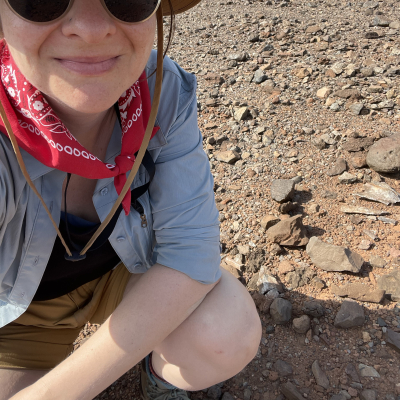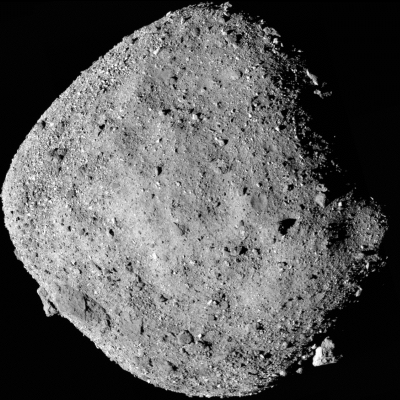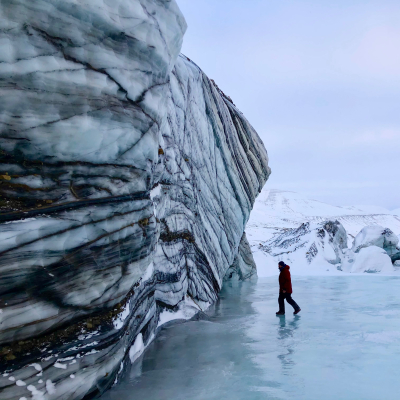News
Stay up-to-date with what's happening in EOAS
Life on Earth after the dinosaurs: Age of the mammals
About 66 million years ago, a mass extinction event wiped out 75% of life on Earth, including the dinosaurs. Yet our mammalian predecessors survived and evolved to thrive in the space left by the dinosaurs. But how? That is the multi-million dollar question EOAS Associate Professor Kendra Chritz and her co-investigators are setting out to answer.
Having been awarded a prestigious and highly competitive $3M USD (~$4M CAD) grant from the Frontier Research in Earth Sciences (FRES) program at the National Science Foundation, the project titled, “How did Terrestrial Ecosystems Rebuild Following the Cretaceous/Paleogene Mass Extinction?”, truly is a multi-million dollar question. The funding will allow a team of geochemists and paleo-ecologists from institutions across North America to study a unique outcrop where terrestrial plant and animal remains from the earliest Paleogene, immediately following the Cretaceous/Paleogene (K-Pg) mass extinction event.
The fossils at Corral Bluffs, Colorado are an extremely rare, comprising extraordinarily well-preserved terrestrial plants and mammals. Terrestrial environments are not typically ideal for fossil preservation. As a result, little is known about how life on land (compared to marine life) adapted and evolved to flourish following the K-Pg mass extinction. However, the ancient wetlands that once existed over Corral Bluffs created the perfect ‘Goldilocks’ conditions needed to capture a snapshot of life on Earth in the years just prior to and following the mass extinction event.
As an expert in minimally-invasive geochemical analysis of fossils, Prof. Chritz was approached by the team at the Denver Museum of Nature and Science to join the project. The ratios of various elements preserved in plant and animal fossils will allow Prof. Chritz and her colleagues to reconstruct ancient climate, environment and food webs. These reconstructions will allow the team to describe how land plants rapidly diversified during the early Paleogene, and how, in turn, early mammals evolved to take advantage of newly available food sources and fill ecological niche spaces left behind by the extinction of the dinosaurs.
Now, living in the era of mammals, much is still unknown about how our earliest lineages rose to prominence. As this study aims to unlock some of these mysteries, it has received significant attention from the media, including Vancouver is Awesome, Richmond News, Burnaby Now, Tri-City News, North Shore News, Squamish Chief, Delta Optimist, New Westminster Record, Powell River Peak, Pique NewsMagazine. You can also tune into CBC’s Daybreak North show, aired on August 21, 2023 to hear Kenra Chritz describe the research in her own words (starting around 1:14:40).
Meet Lindsay Nelson - Earth Science Educational Field and Laboratory Coordinator
Lindsay is the Earth Science Educational Field and Laboratory Coordinator at the University of British Columbia (UBC). She recently joined the university, previously working as a field geologist in private industry. After spending many years in field camps across the Yukon, Northwest Territories, Nunavut, British Columbia, and Ontario, she is now focused on using those experiences to support undergraduate students. While she was completing the Masters of Land and Water Systems program at UBC in 2020, Lindsay became more interested in how people teach and learn in the natural sciences. Through her current role, she is excited to pursue this interest further by collaboratively developing the lab and field components that are essential to Earth science education.
Professor Dominique Weis set to receive samples from asteroid Bennu
In September of 2016, the NASA OSIRIS-REx spacecraft launched from Florida to an asteroid named Bennu, or near-Earth object 101955. Bennu’s orbits the sun once every 1.2 years along a path very similar to Earth’s own orbital path. The NASA spacecraft began orbiting Bennu in 2018 and collected samples from the asteroid in 2020. Now, OSIRIS-REx is on its way back to Earth with those samples.
The samples collected by OSIRIS-REx will be investigated by American and Canadian scientists, including Dominique Weis, a geosciences professor at the Department of Earth Oceans and Atmospheric Sciences at UBC.
Bennu consists of carbon-rich rock material thought to have broken off some larger object around one billion years ago. This makes Bennu one of the older rock formations in our solar system. Bennu’s relatively old age and rich organic matter composition may offer researchers insights into the origins of life on Earth and potential water sources within the solar system.
Glacier media and EOAS team up to launch new forecasting service, Weatherhood
Nicolas Duboc, an Earth Oceans and Atmospheric Science graduate student in Roland Stull’s laboratory, and research assistant Kat Pexa are preparing to launch WeatherHood in collaboration with Glacier Media this summer. This free weather forecasting service uses a novel network of weather sensors stationed around metro Vancouver to provide real-time data, making it the first hyperlocal weather forecasting service of its kind in North America. Scroll down to watch our interview with Nicolas and Kat!
Since the project began in June 2022, the team has installed 60 weather stations across a variety of urban, forested, and mountainous regions. The hyperlocal aspect of this solution will allow researchers like Dr. Roland Stull, who directs the Weather Forecast Research Team, and their students to track differences between microclimates within Vancouver’s variable landscapes. In turn, these results will enable scientists to study the effects of land-use and local geography on weather and climate.
Now that WeatherHood has launched, users can track current conditions, hourly, multi-hour, and 7-day forecasts specific to their location within the Weatherhood network, spanning north to south from Whistler to Tsawassen and east to west from Chilliwack to Sechelt. This immediately accessible data will aid the city in forecasting hazards, managing transportation and recreational services, and making decisions regarding infrastructure installation projects.
While WeatherHood enables easy weather-tracking for Vancouverites, installing the weather stations for the forecasting service was no easy task. Since June, the Weatherhood team has been busy setting up weather stations throughout the city. Nicolas and Kat shared stories of scaling the roofs and summits of some of Vancouver’s most iconic sites, often with heavy backpacks full of equipment, to deploy weather stations. One of their most memorable jobs included a trip to the Vancouver Art Gallery where they were ushered through back doors, among fine art, to set-up a suite of sensors on the roof.
Methane release from retreating glaciers in the Arctic
On a trip to Norway to give a presentation on microbial production of methane (methanogenesis), Dr. Sasha Turchyn of the University of Cambridge was met with questions from local scientists about methane recently discovered in glacial fed groundwater springs. Curiosity surrounding this new methane source led to a coalition of scientists, including UBC Earth Oceans and Atmospheric Sciences Assistant professor Hal Bradbury, seeking to uncover the mechanism of this novel kind of methane release, the original methane source, and the scale of methane emissions from glacial groundwater springs. The group’s findings were published last week in Nature Geoscience in an article titled ‘Groundwater springs formed during glacial retreat are a large source of methane in the high Arctic’.
The fieldwork led by Gabrielle Kleber included groundwater sampling from 78 terrestrial glaciers on Svalbard over three years. The research revealed methane previously trapped under glaciers or permafrost is seeping out of the ground as glaciers retreat faster than permafrost can expand, leaving a gap in the ice cap through which methane can escape. The glacial meltwater forms the groundwater springs that carry methane out from under the glaciers. These methane emissions, equivalent to ~8% of Norway’s anthropogenic oil and gas emissions, primarily come from thermogenic reactions taking place over thousands of years in organic-carbon rich bedrock underlying the glaciers, rather than from a more recent biological source. These are the same kind of rock formations valued for their oil and gas reserves.
Unfortunately, emissions of this kind are likely to increase as the process forms a positive feedback loop, prompting further glacial retreat. Glaciers that run into the ocean, known as marine-terminating glaciers, make up most of the glaciers in the high arctic and do not currently contribute to methane emissions from groundwater springs. However, in the coming years as these glaciers retreat inland, they may also become an important source of methane. The article concludes by urging climate experts to consider these kinds of feedback mechanisms, which are likely present in other parts of the Arctic besides Svalbard. Such unaccounted for feedback loops are likely to blame for the rapid rate of Arctic warming that is far exceeding model predictions.
Due to the high impact nature of this research, it has already gathered much attention from the scientific community and beyond. Many news outlets including the Washington Post, Vancouver Sun, Insider, and even Men’s Journal have posted articles highlighting the recent publication.
Are viruses keeping sea lice at bay in wild salmon?
Read the UBC Science article: Are viruses keeping sea lice at bay in wild salmon?
More than 30 previously unknown RNA viruses have been identified in sea lice, parasitic copepods (small crustaceans) that have been implicated in the decline of wild salmon populations and causing problems to the fish aquaculture industry worldwide.
This research, recently published in PLOS Pathogens, was carried out by Dr. Tianyi Chang, Dr. Brian Hunt, Dr. Curtis Suttle from the Department of Earth, Ocean and Atmospheric Sciences, University of British Columbia and Dr. Junya Hirai from the Atmosphere and Ocean Research Institute, University of Tokyo.
The researchers obtained and analyzed RNA data from sea lice removed from out-migrating juvenile salmon collected in the waters surrounding the Discovery Islands and Broughton Archipelago on the northeastern side of Vancouver Island, as well as from farmed salmon in Chile.
The paper sheds greater light on the types of viruses being carried by sea lice, and how the viruses and host are interacting. “We found many more types of viruses than are known in sea lice or their distant relatives; the lice are mounting an immune defense response to many of these viruses indicating that they are replicating,” says Dr. Curtis Suttle, senior author of the paper. “In a natural system, viruses may prevent explosions in sea-lice populations by rapidly replicating when densities become high.”
Read/Listen to the Cortes Currents interview with Dr. Curtis Suttle: The viruses infecting sea lice
Read the paper: Divergent RNA viruses infecting sea lice, major ectoparasites of fish





